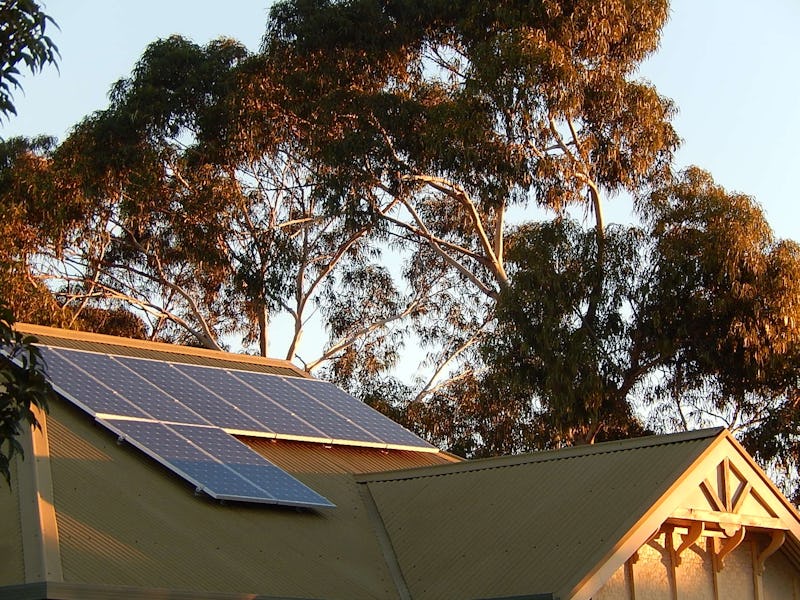Making Solar Panels Can Be a Dirty Business
Which companies are responsible? Which aren't? The answers aren't so easy.

Transforming raw quartz, silver, and other substances into high-tech photovoltaic cells isn’t exactly an organic or natural process. So obviously some companies do it more responsibly than others.
The Silicon Valley Toxics Coalition (SVTC) — which has tracked the environmental footprint of the tech sector for decades — hopes that by spotlighting which actors in the solar market are acting responsibly (or irresponsibly) they can keep the whole field honest.
Dustin Mulvaney, SVTC’s scientific advisor and an assistant professor of environmental studies at San José State University, tells Inverse that monitoring how solar panels materials are sourced isn’t an easy job.
“It’s hard to verify and compare companies, because you’ve got companies that make everything from polysilicon to making panels, or modules, and then you have people who just buy everything and slap the modules together,” he explains. “It’s hard to tie chemical use to any particular panel.”
As the coalition’s executive director Sheila Davis once toldNational Geographic, the hope is that efforts like SVTC’s can encourage solar start-ups to think of the environmental impacts of their whole process and supply chain as they scale up.
If that happens, she says, “maybe over the next 10 or 15 years — as these panels begin to come down, the first wave of them, and we’re beginning to recycle them — then the new panels that are on the market are zero waste.”
SVTC released its 2018 industry survey packets earlier this summer, but you can see who the current sustainability frontrunners are in the 2016-2017 chart below.
The Silicon Valley Toxics Coalition (SVTC) has been tracking high-tech manufacturing practices since 1982. According to their last assessment of solar panel manufacturers, California-based SunPower and German firm SolarWorld were among some of the most environmentally responsible in their production process.
One of the more surprising things about scorecards (compiled from a self-reported survey) is how feasible it has been for less responsible solar cell producers to clean up their act.
Just a few short years ago, Chinese manufacturer Jinko Solar was dealing with a shareholder lawsuit and public protests over the toxic waste it had been accused, as Reuters reported it, “of concealing that one of its factories was dumping toxic waste into a nearby river” at its Zhejiang facility. Today, it’s one of the top five most ecologically conscious manufacturers of photovoltaic solar cells.
What Goes In to Making a Solar Cell?
Though plants may elegantly draw their energy from sunlight, the steps required to get photovoltaic solar cells to do the same thing are much more complicated.
Here’s just a few of them: First quartz is mined and then refined into metallurgical-grade silicon in giant, energy-intensive furnaces. That silicon is then further purified into polysilicon via a process that requires hydrochloric acid (a pretty serious acid) and produces toxic silicon tetrachloride as a by-product. Finally, the panels themselves are fashioned out that polysilicon; they’re etched with hydrofluoric acid (an even more serious and very dangerous acid) in a method that necessitates the use of a lot of sodium hydroxide, water and electricity.
Some of the best new ideas for recycling solar panels also involve these same hazardous substances and — much like the manufacturing process itself — these recycling processes can contribute to carbon emissions through their own heavy energy requirements.
Further complicating matters, the reprocessing equipment alone can cost solar manufacturers tens of millions of dollars, according to IEEE Spectrum.
And yet, recycling is going to be essential for the solar industry’s long-term health.
“The problem is that if you don’t start closing the loop on some of these materials, you have an issue of scaling the technology,” Mulvaney says. “So, for example, with crystalline silicon, the industry uses almost 20 percent of the silver supply.”
Expensive materials, not just silver, but also elements like tellurium and indium, are currently essentially parts of most solar cells — and their prices are only likely to go up as more and more of the readily available quantities find their way to the junkyard.
“Where the promising stuff happens is Europe, where they actually have a big overarching law,” Mulvaney says. “They have required them to take back and recycle solar panels for over five years now.”
That’s obviously not the case here in the U.S., but for the time being, we in America do have SVTC’s scorecards, at least. That’s something anyone can take into account while shopping for their renewable solar energy needs.